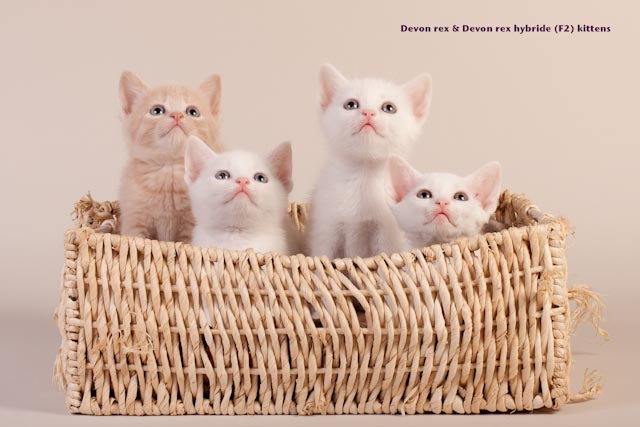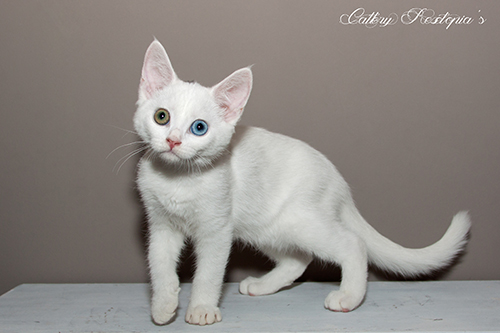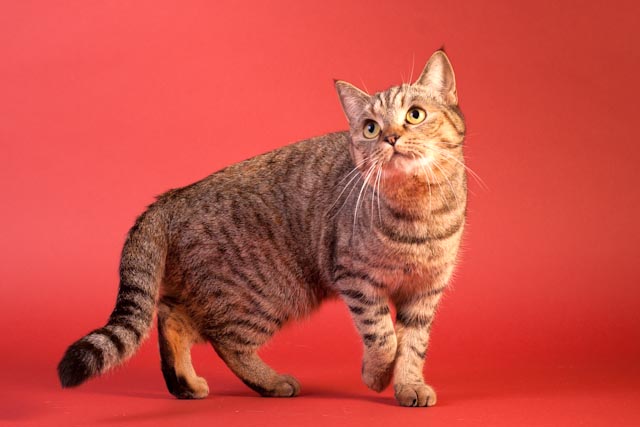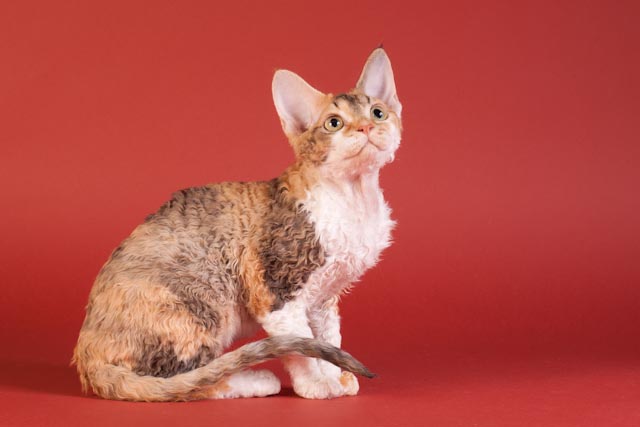Outcross
Outcross, or better said crossbreeding, is done to add new unrelated genes to a breed. This can be done due to high inbreeding percentages within the breed, but also to add new colour varieties (like cinnamon, siamese point, etc.) or to improve appearance.
We have started an outcross program to lower the inbreeding rate and with that improve health.
We can all imagine that inbreeding leads to severe health issues (smaller litters, less fertility, disformations, increase of hereditary diseases) and the immune system is lowered. This is what we try to avoid in our breeding program.
But still, if you want to add up to a certain breed standard, line breeding can be done sometimes to be able to breed a prefered/better type. Preferably not closer then a niece - nephew mating.
Of course this has to be done carefully, same as has to be done with a crossbreeding, cause of course we don't want to add unwanted treats in our breed.
It's very important to test for common hereditary diseases, also for the breed the cross is done with.
For an outcross we need to ask approval from the breed commission first (FIFe). At Mundikat this also count for the following generations.
A first cross, with a different breed is will only give straight coated kittens, like normal shorthairs (or longhair), this because the Devon rex gene is recessive. Two parents who carry the curly gene or are curly themselves, are needed to give the curly coat to their offspring.
The result of a first outcross is called F1, or sometimes GEN 1, hybrid or variant.
When you breed a F1 to a Devon Rex, the litter will be mixed; curly and straight coated kittens will be born, it's a 50 - 50 % chance. This generation is called F2 or GEN 2.
A curly F2 mated to a Devon Rex will give only curly kittens again and is called F3.
Crossbreeds will be registered in RIEX register. After 4 generations of Devon Rex they will be registered in LO (Livre d'Origine) again. This will be generation F5.For the character, the unique Devon Rex character is preserved pretty well, a F2 will already have most part of the typical Devon Rex character and a curly F2 can sometimes hardly be recognized as not purebred. The type is also preserved well when we use good typed Devon Rexes for the outcross breeding.
A curly F2 can be shown in control class. Before you register for the show you will have to ask the breed commission approval in writing.
The cat needs to be judged by two judges and achieve 'Excellent' result, then the cat can be registered as Devon Rex (DRX) in RIEX, instead of non recognized shorthair (XSH).
It is very important to select well on character, it has been said that because of outcross the typical Devon Rex character is lost, but this is a misunderstanding and often not based on facts.
As we look at the history and the structure of the Devon Rex, we can see that many other breeds are crossed earlier. This was necessary to build up the breed, after all the breed originates from one cat (named Kirlee).
Partly by crossing with different breeds, the Devon Rex got his typical and unique character (and appearance).
The unique character is certainly not lost, as long as combinations are chosen carefully and will be breed back to the Devon Rex.
Same as with appearance, we also need to select for character to preserve all the unique features of the breed, but with that part of renewal!
Why not use unrelated bloodlines then?
Outcross also means the cross of unrelated bloodlines. Of course it is also very important to use unrelated bloodlines, to be able to also get renewal.
The difference is that the base of those unrelated bloodlines is still the same, they all lead back to Kirlee, the very first Devon Rex.
The foundation coefficient is pretty high (usually around 40 %) and can only be reduced by using different breeds, with a different basis of genes.
In this way the general vitality and immunty is increased.
More about outcrossing can be read in the article written by Marjan Boonen, Cattery Boonland:
'Cherish the old, cheer on the new!"
Here an article on Pawpeds about genetic diversity
Coat lengths
Sometimes you will see a Devon Rex with quite a lot, fuzzy, long (specially behind the ears and the tail) and curly coat; a longhair!
This can happen if two longhair carriers are mated. However this is brought into the breed by outcrossing with longhaired cats like Persians, it turned out that Kirlee, the very first Devon Rex, also was a longhair carrier.
So the longhair gene was in the breed from scratch!
Of course it is meant to breed shorthaired Devons, after all it is a shorthaired breed. But the unique appearance of a longhaired Devon makes them a super fun pet.
Nowadays we can make DNA tests to see if a cat is a longhair or a carrier. The longhair gene is recessive; both parents need to either be longhair or carry the longhair gene to be able to forward it to their offspring.
Breeding with longhaired Devon Rexes is not wanted, but it is easy to eliminate the longhair gene within 2 generations.
You could also exclude all carriers from breeding, but with an already small gene pool, it is not wise to exclude all carriers or even longhairs. A lot of good potential breeding cats would be lost then.
It is easy to mate them with non carriers and in this way eliminate it fast and easy if wished for, even with help of DNA testing if you want to exclude it quickly.
Besides longhair, boldness (partialy) can be a common issue which can be a lot harder to eliminate.
Kittens will almost always go through a moult where they become bold. Usually this is only temporary and they will get their nice coat back as an adult.
Kittens who are born fully coated will usually get a good coat as an adult. With the bolder kittens it will be a wait and see... if the parents have good coats, the bigger the chance the kittens will get a nice coat as well.






